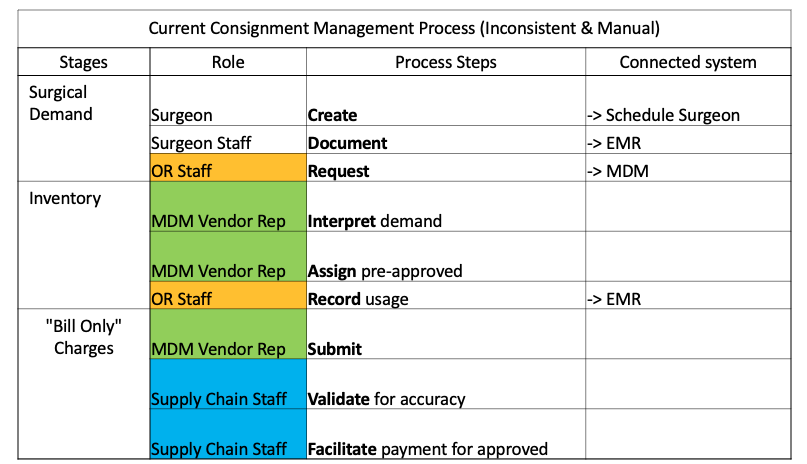The right Hospital OS tool improves surgical throughput for health systems by benchmarking, “right-sizing” and tracking consigned medical device inventory, every step of the way. 
Introduction: Current Processes
Provider processes for supplying inventory to surgical cases are typically fraught with clinical variation and errors due to significant manual components and human intervention required to manage it. With the right digital tools, accurate automation and advanced analytics provide unprecedented visibility and control to consignment inventory management.

Fig 1: The majority of steps shown above are currently impeded by disconnected manual processes.
The consignment management process can be broken down into eight common steps that describe the requesting, fulfilling, and billing of case-based inventory usage. This helps to (a) highlight specific areas of the supply chain, and (b) show how each current step can significantly benefit from new, innovative inventory automation capabilities, as described below:
1. Integrate Scheduling Interface to EMR
Current Manual Process: A surgeon schedules a surgery after seeing a patient in the office.
Automated Innovation: Using a simple scheduling interface that sits on top of the EMR would help streamline implant & instrument selection.
2. Determine Requests using AI
Current Manual Process: Surgeon Staff will book a surgery within an allocated "Block" time, or as a Trauma "add-on". The vendor Rep is typically notified of a case by the Surgeon Staff/Resident at the time of this booking.
Automated Innovation: Instead, automated AI (artificial intelligence) & ML (machine learning) algorithms could be used to analyze the digital booking record and identify, interpret, and communicate surgical demand immediately as the procedure is being booked.
3. Allocate Inventory within a Sourcing Matrix
Current Manual Process: The OR team will usually review the schedule and identify required inventory 48-96 hours before surgery. Through calls/texts to the Vendor Rep and SPD, the OR team then confirms inventory availability and Vendor Rep support.
Automated Innovation: More efficiently, a digital “Sourcing Matrix” analyzes all locations, allocates inventory and provides logistical transparency for OR, SPD and Supply Chain teams.
4. Use Biometric Templates for Auto-fulfillment
Current Manual Process: The MDM Vendor Rep determines the consignment/loaner mix for each surgical procedure and communicates with SPD and Supply Chain to coordinate inventory logistics, billing and replenishment.
Automated Innovation: Utilizing integrated biometric templating to determine a narrow probable sizing range, "skinny kits" allow focused fulfillment, broader utilization of inventory, and condensed shipments.
5. Initiate Billing from a Single Scan
Current Manual Process: Surgical Inventory is delivered to the OR on a Case Cart and/or hand-delivered by the Vendor Rep. Items intended for patient usage are opened on the "sterile field" and recorded within the EMR for patient documentation and billing.
Automated Innovation: OR Staff can scan used inventory using an EMR-embedded tool, ensuring accurate usage capture data is communicated independent of Vendor Rep attendance, and often before the surgery is complete. This streamlines usage tracking and billing processes that follow.
6. Send System-Generated Documentation
Current Manual Process: If Vendor Rep is present during surgery, they will document the items used and create a "bill-only" charge sheet which is submitted to Supply Chain Staff for billing and payment.
Automated Innovation: With the ERP-embedded "bill-only" tool described in step 5, any required documents are immediately and automatically generated with all required information and securely sent to necessary parties.
7. Remove Human Error
Current Manual Process: Supply Chain/Material Management staff validate each "bill-only" line item for approved usage and contracted price. EMR documentation from the surgery is cross-referenced against "bill-only" charges to ensure billing accuracy for the patient and hospital.
Automated Innovation: Again, this step becomes automated within the tool described above. Human approval capabilities are supported, yet become less necessary with the increased accuracy.
8. Auto-generate POs and Replenishment
Current Manual Process: Supply Chain/Material Management staff submit a Requisition in the ERP in order to obtain a Purchase Order for each Vendor's "bill-only" charges associated with a given surgery. The Vendor Rep must contact the hospital to receive the P.O. and payment.
Automated Innovation: A single scan when capturing usage pre-empts the Rep's "bill-only", automating and expediting PO generation and replenishment orders.
Conclusion: A Singular Solution
By automating and streamlining each step through the case management process, hospitals can increase surgical throughput and streamline case-based consignment activities. Movemedical’s Hospital OS and SingleScan inventory tool leverages long-standing relationships with vendors, closing manual and cumbersome communication gaps through accurate digital transformation.
If automating your consignment management processes makes sense for your business, let’s have a conversation about it:
info@movemedical.com / call 877.469.3992
or watch this VIDEO (executive case study)
Learn More:
https://www.movemedical.com/fix-medical-device-inventory-reduce-costs/











